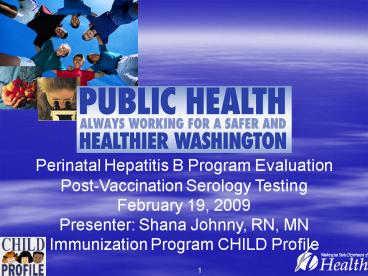Perinatal Hepatitis B Program Evaluation PostVaccination Serology Testing PowerPoint PPT Presentation
1 / 21
Title: Perinatal Hepatitis B Program Evaluation PostVaccination Serology Testing
1
Perinatal Hepatitis B Program Evaluation
Post-Vaccination Serology Testing February 19,
2009 Presenter Shana Johnny, RN, MN Immunization
Program CHILD Profile
2
Overview of Washington State Perinatal Hepatitis
B Prevention Program
- 1990, Initiated with CDC funds
- Contract with 35 Local Health Jurisdictions
(LHJs) to provide services - Components
- State-supplied hepatitis B vaccine
- Laboratory testing
- Information, education, consultation and
technical assistance
3
Rational for Selecting Evaluation Activity
- Identify barriers to post-vaccinations serology
testing - Increase understanding of barriers providers are
facing in practice - Develop strategies to increase post-vaccination
serology
4
Post-Vaccination Serology Testing Data
5
Evaluation Goal
- To increase awareness, knowledge and practice
with perinatal hepatitis B post-vaccination
serology
6
Stakeholders and Partners
Perinatal Hepatitis B Coordinator
Local Health Jurisdictions
Evaluation Plan
Within Reach-API Hepatitis B Task Force
DOH-Immunization Program CHILD Profile Staff
Communicable Disease EPI
DOH-MCH Epidemiologist
Other Health Care Professionals
7
Objectives
- 1. By January 31, 2009, determine the number of
providers identified by LHJs as caring for
infants of HBsAg moms and number of providers
with standing orders in place for post
vaccination serology. - 2. By March 31, 2009, survey providers identified
as caring for infants of HBsAg moms to determine
the percent of those providers who are - a. aware of the value of early detection and the
criticality of post serology testing for infants
born to HBsAg positive moms - b. educated on the value of early detection and
the criticality of post serology testing for
infants born to HBsAg positive moms.
8
Objectives (Continued)
- 3. By December 31, 2009, increase the number of
providers identified as caring for infants of
HBsAg positive moms who are - a. aware of the value of early detection and the
criticality of post serology testing for infants
born to HBsAg positive moms by 5. - b. educated on the value of early detection and
the criticality of post serology testing for
infants born to HBsAg positive moms by 5. - By December 31, 2009, the percent of providers
who have written standing orders for post
serology testing for infants born to HBSAg
positive mothers will increase by 10. - By December 31, 2010, the rate for a three-year
period from December 31, 2006-December 31, 2009,
for post serology testing for infants born to
HBsAg positive mothers will increase from 58 to
70 (increase of 42 infants/yr).
9
(No Transcript)
10
Evaluation Activities
- Identify LHJs and geographical areas where
post-vaccination serology is low. - Identify providers where post vaccination
serology is low
11
Evaluation Activities
- Plan outreach to providers to assess awareness of
why infants born to HBsAg positive moms are not
getting post-vaccination serology testing (
pre-test survey) - Use findings to develop strategies to increase
the testing rates for these infants (post-test
survey)
12
Short-Term Outcomes
- Providers are more aware of importance of
post-vaccination serology testing - Providers are educated on the value of early
detection - An increased number of providers who are
conducting post-vaccination serology testing - An increase number of LHJs providing
consultation with providers
13
Data collection and Analysis
- Evaluation question 1
- To what degree did the number of providers who
are aware of the value of early detection and the
criticality of post vaccination serology testing
for infants born to HBsAg positive mothers
increase from March 31, 2009 to December, 2009
14
Data collection and Analysis
- Evaluation question 2
- To what degree did the number of providers who
have been educated on the value of early
detection and the criticality of post-vaccination
serology testing for infants born to HBsAg
positive mothers increase between march 31, 2009
and December, 2009
15
Data collection and Analysis
- Evaluation Question 3
- To what degree did the number of providers have
written standing orders for post-vaccination
serology testing for infants born to HBsAg
positive mothers increase from January 31, 2009
to December, 2009
16
Data collection and Analysis
- Evaluation Question 4
- To what degree did the rate for post-vaccination
serology testing for infants born to HBsAg
positive mothers increase from December 2006
(baseline collected in 2007) to December 2009
(collected in December 2010)
17
Long term outcomes
- An increase percentage of infants born to HBsAg
positive moms who receive post-vaccination
serology testing - An increase ability to track efficacy of
Hepatitis B vaccination thru post-vaccination
serology - A decrease in hepatitis B disease in infants born
to HBsAg positive moms
18
Challenges in Developing a Plan
- Agreement of consensus on plan with stakeholders
and partners - Methodology
- Resources. Fitting into overall workload
19
Lessons Learned
- Partnerships Work cant do it alone!
- Target efforts cant do it all.
20
Acknowledgements
- Washington State
- Department of Health
- Lin Watson
- Janna Bardi
- Marsha Fraser
- Pat DeHart
- Gary Gant
- Katherine Harris-Wollburg
- Debbie Carlson
- Chrystal Averette
- Steve Bichler
- Within Reach Organization
- Kim Nguyen
- Local Health Jurisdictions
- Shelly McKeirnan Public Health
Seattle King County - Jackie Ramsey
- Snohomish Health District
- Ginger Dobberthan Southwest Washington Health
District - Denny Hursch Yakima Health
District - Denise Stinson Tacoma-Pierce
Count Health Department - Delores Dorffeld Thurston
County Public Health and Social Services
21
This document
- This document can be found on the CDC website
athttp//www.cdc.gov/vaccines/programs/progeval/
downloads/wash-eval-02-09-508.ppt

